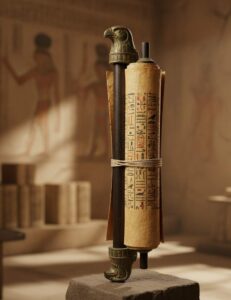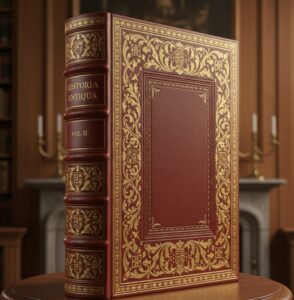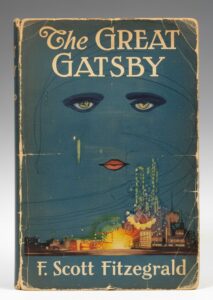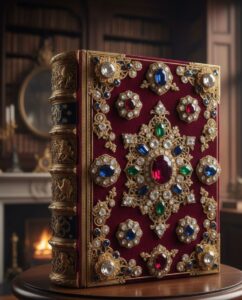The Secret Life of Spines: Rare Book Bindings That Tell a Story
Imagine holding a book that whispers history—its leather spine creases softly under your thumb, the cover smells tangy from age, the gilded edges shimmering faintly in the light. That book isn’t just words on paper. It’s craftsmanship, provenance and a legacy all tied together.
When you pick up a rare book, what do you see first? What do you feel first? Yes, you see and feel the antique book cover. What we are going to be talking about is book binding: the method in which the front and back covers are fastened over the actual book pages.
Book bindings can be decorative as well as practical, helping protect the pages from the elements and adding an elegant touch to any book. Are you a collector looking to move beyond “first edition” hunting? Do you want to understand the true provenance and artistry that turns a rare book into an invaluable masterpiece? Then it’s time to become fluent in the language of the spine. In this article, we’ll explore rare book binding techniques, explain different book binding methods, and learn why they raise the value of a book.

Also Read: Factors Influencing Antique Book Value
What Are Book Binding Techniques

Book binding techniques are the methods, materials, and styles used to secure the pages and attach them to a cover. In the rare book world, these techniques are critical for establishing a book’s authenticity, age, and scarcity.
The value doesn’t rest solely on the famous author or the first printing date; a book still in its original, unmarred 17th-century binding (or a unique historical binding style) can fetch prices exponentially higher than a rebound copy.
From Scrolls to Leather Spines: Types of Book Binding
- Scrolls and Early Codices (Before 2nd Century CE)

Technique: Papyrus and Parchment Scrolls
Before books had covers, texts existed as scrolls — long sheets of papyrus or parchment rolled around wooden rods. A reed or wooden stick, often capped with ornamental elements, served as a central axis around which the papyrus was wound.
Material: Papyrus in Egypt; parchment (treated animal skin) later in Greece and Rome.
Example:
The Book of the Dead (Egypt, c. 1500 BCE) – Papyrus scrolls housed in tombs; texts written horizontally and rolled.
- China – Silk and Thread
China has been cultivating its own traditions of book binding. Thread-bound “butterfly books” were a Chinese bookbinding technique where sheets of paper were printed, folded in half, and then sewn together along the folded edge with silk threads, creating a spine. The name “butterfly book” comes from the way the pages open, resembling the fluttering wings of a butterfly
Material: Silk and Thread
Example: The Diamond Sutra: A famous example is the Diamond Sutra, the world’s earliest known dated printed book from China, which is a butterfly-bound scroll.
- Coptic Binding (2nd–6th Century CE, Egypt)
Technique: Coptic Sewing with Wooden or Leather Covers
The first recognizable “book” form appeared in Christian Egypt. Sheets of papyrus or parchment were folded into sections and sewn through the folds with a chain stitch across an exposed spine. Features:
- Distinctive chain-stitch sewing is visible along the spine
- Opens completely flat
Example:
The Nag Hammadi Codices (4th century CE)
- Calf Leather Binding (16th century)

Technique: Smooth Calf Hide Binding
Calfskin has long been the standard leather for bookbinding. It’s fine, even texture and ability to take gilt tooling made it ideal for elegant bindings from the 16th century onward. Calf can be natural or dyed in many tones—brown, red, tan, or even black.
Features:
- Smooth, grainless leather surface
- Variety of finishes (tree calf, sprinkled, mottled)
- Marbled or speckled page edges
Example:
Samuel Johnson’s “Dictionary of the English Language” (1755) – Issued in full polished calf with gilt spine labels and raised bands.
- Morocco Leather Binding

Technique: Goatskin Binding, Often Dyed and Highly Decorated
Moroccan leather, made from goatskin, emerged in Europe via North Africa and became the gold standard for luxury bindings.
Features:
- Distinctive pebbled grain texture
- Brilliant dye colours—red, blue, green, or purple
Example:
The Kelmscott Chaucer (1896) – Deluxe copies were bound in full blue Morocco binding.
- Original Boards (c. 1700–1830)
Technique: Paper-Covered Boards
Before cloth binding became standard, printers and booksellers issued books in temporary paper-covered boards—what collectors now call “original boards.” These allowed buyers to later commission custom bindings.
Features:
- Stiff pasteboard covers, often covered in blue, grey, or marbled paper
- Paper spine label printed or handwritten
Example:
“Pride and Prejudice” (1813, T. Egerton) – Originally issued in drab paper-covered boards with a printed spine label.
- Cloth Binding (Original Cloth, c. 1830–1900)

Technique: Publisher’s Cloth Binding
Around 1830, book production entered a new industrial phase. Instead of leather, publishers began covering hardback boards with cloth—usually cotton, linen, or buckram—offering a more affordable and decorative alternative.
Features:
- Full or partial cloth cover stretched over paper boards
- Gilt or blind-stamped decorations, sometimes multicoloured
Example:
“Alice’s Adventures in Wonderland” (1865, Macmillan) – Issued in bright red cloth with gilt pictorial cover and gilt edges.
- Dust Jackets (c. 1830s Onward)

Technique: Protective Paper Wrappers
Dust jackets first appeared in the early 19th century as protective paper covers wrapped around cloth- or leather-bound books. Initially discarded by readers, they are now among the most prized features of collectible books.
Features:
- Paper wraparound cover with printed design and flaps
- Protects binding from wear and sun damage
Example:
- Scott Fitzgerald’s “The Great Gatsby” (1925) – Its original dust jacket, designed by Francis Cugat, is now worth far more than the book alone.
- Vellum Binding
Technique: Specially Treated Calfskin Binding
Vellum—fine, polished calfskin—has been used for both writing surfaces and bindings since medieval times. It’s strong yet elegant, often slightly translucent, and was favoured for deluxe editions and illuminated manuscripts.
Features:
- Smooth, ivory-coloured surface
- Sometimes gilt-decorated or painted
Example:
The Gutenberg Bible (c. 1455) – Several surviving copies were printed on vellum.
- Jewelled Bindings (Various Periods)

Technique: Bindings Inlaid with Precious Metals and Stones
Jewelled bindings or treasure binding represent the zenith of luxury bookmaking, reserved for royal commissions, religious texts, or presentation copies. Artisans adorned covers with gold, silver, enamel, and real gemstones set into the boards or spine.
Features:
- Precious metal covers or inlays
- Elaborate chasing, repoussé, or enamel work
- Often made for display rather than reading
Example:
The Lindau Gospels (c. 880 CE) – Bound in gold and studded with sapphires, garnets, and pearls.
The Rare Book Value Equation: Binding as Multiplier
Why do these specific bindings command such high prices? The value is a result of four primary factors:
- Originality: Collectors prioritise a book in its Original Publisher’s Boards or Original Wrappers or, in the case of commissioned works, the Original Custom Binding by a known master binder. Rebound books, no matter how beautiful, almost always decrease collectible value unless done by a historically significant artisan.
- Historical Continuity: Bindings like Coptic and Vellum show an unbroken link to early book production practices.
- Craftsmanship and Provenance: Unique, elaborate styles represent an extra layer of expensive, skilled artistry. Collectors pay a premium for this craftsmanship, especially if the binder is known
- Survival Rate: Fragile structures like Vellum bindings were often re-bound by later owners for durability or fashion. A copy that survived centuries in its original form is inherently scarce.
Sourcing the Unconventional: Finding Rare Bindings Online
While traditional brick-and-mortar rare book dealers offer expertise, the largest selection—and best chance of finding these unique and rare antique books is typically found through high-end online auction houses and specialized platforms.
Platforms like Giftex offer the necessary cataloguing details and provenance checks to give a collector confidence in buying such specialized items.
The Spine That Holds History Together
From the papyrus scrolls of ancient Egypt to modern fine-press art books, binding has always been more than mere protection—it’s identity, history, and artistry rolled into one. Each era brought innovations in material and method, each telling its own story through texture and structure.
For collectors and historians alike, understanding binding techniques is like reading the hidden story on a book’s spine. By learning how to spot quality bindings and understanding why they matter, you’re empowered to make stronger acquisition choices and preserve those treasures for the future.
Next time you pick up a rare book, pause and look: the spine, seams, materials, and even stitching speak volumes. Behind the words lies a structure that can elevate the book’s history and value.






